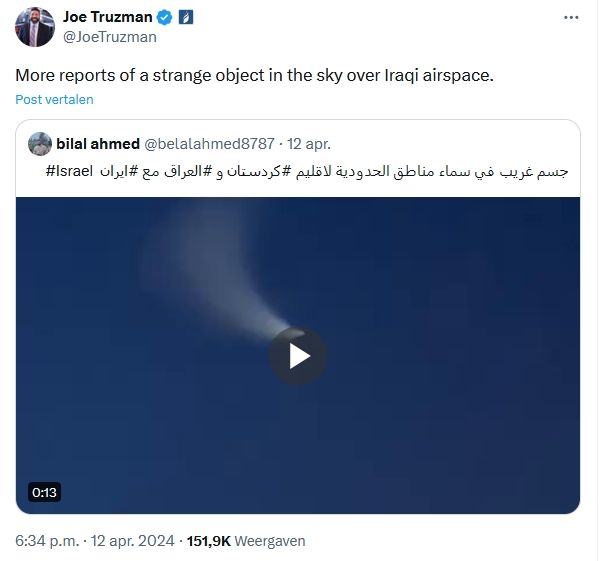 |
| click to enlarge |
On 12 April 2024 near 16:00 UTC, the Russian Armed Forces test-fired an unarmed ICBM from Kapustin Yar, targetting the test range at Sary Shagan at a distance of some 2000 km. The missile was likely a TOPOL-M.
In the image above, I have modelled the likely trajectory, assuming apogee at 1000 km altitude as in previous tests. Below is Russian MoD footage of the launch:
The missile launch was widely seen as a bright comet-like object in the sky, in Russia as well as in the Middle East, with reports from as far south as a.o. Iran and Iraq. As many there where in anxiety about an expected Iranian retaliation attack on Israel, it created a bit of a stir.
In the aftermath, there were some people that expressed doubt whether a Russian ICBM test would be visible from the Middle East. So I reconstructed the area of visibility to show that it is in fact visible.
In the map below, I have drawn isocircles around the estimated point of cut-off of the missile's third stage. That stage cut-off happened after 3 minutes of flight at an altitude of about 570 km (there is some leeway in both figures possible, but in general the figure below will give you a good indication of the area of visibility).
 |
| click map to enlarge |
The isocircles give you the altitude in the local sky as seen from a region encompassing southern Russia and the Middle East.
As can be seen, the area of visibility is large, and horizontally extends about 2600 km from the geographic location of stage engine cut-off, to as far as southern Iran.
Bar the first few tens of kilometers, the trajectory was fully sun-illuminated, and as a result the exhaust clouds of the missile were also sun-illuminated, making them shine brightly in the sky.
That exhaust clouds from the upper stages of missile launches can be seen over a avery large area isn't something new. Russian ICBM tests from Plesetsk have multiple times resulted in sightings of bright "spirals" in the Arctic sky (e.g. here). Chinese tests have also been observed, e.g. this example that was observed from South Korea in 2019, which I further analysed here. Meanwhile, the post-boost vehicles of ICBM's/SLBM's sometimes also cause visible phenomena in the sky: see my analysis of one such sighting from La Palma in 2013 related to a US Trident SLBM test for example.


No comments:
Post a Comment
Note: only a member of this blog may post a comment.